The mourning cloak butterfly (
Nymphalis antiopa) emerges from its hibernaculum on the first warm day in April, when the landscape is still brown from winter and everyone is looking for signs of spring. It can be a delight to see a butterfly this early in the season. No flowering plants with nectar are available to these butterflies this early, so they seek out alternative food sources, including sap flows from trees. It’s not unusual to find several mourning cloaks feeding on sap from the wound on a maple tree.
These long-lived butterflies can be seen at different times during the year and survive for about 10 months as adults. Here you’ll learn about their life cycle, larval host plants and favorite nectar plants.
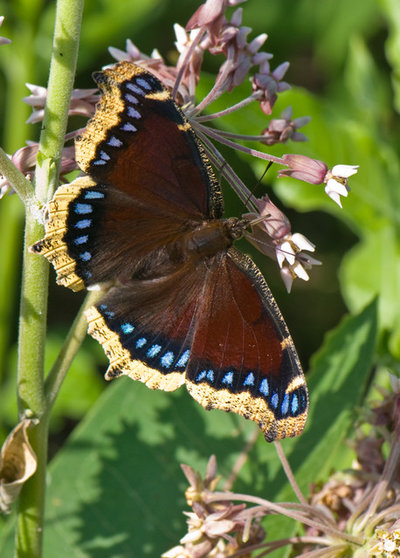
Holm Design & Consulting LLC
Family: Nymphalidae (brush-footed butterflies)
Latin name: Nymphalis antiopaCommon name: Mourning cloak butterfly; a secondary name for the caterpillars is spiny elm caterpillars
Distribution: North America, including Mexico, and Europe
Habitat: Woodlands, wetland edges, gardens, meadows, prairies, old fields and farms
Shown: A mourning cloak butterfly visiting common milkweed (
Asclepias syriaca)
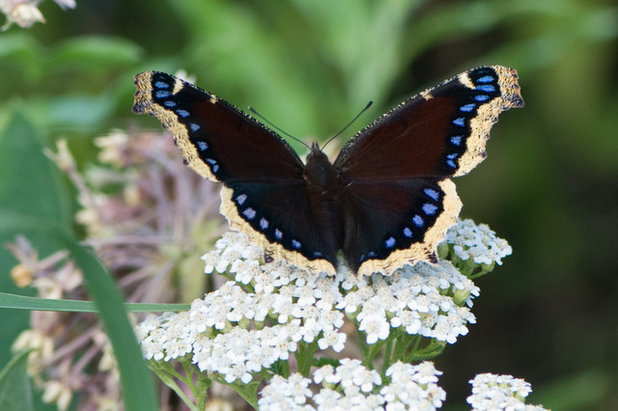
Holm Design & Consulting LLC
When to look for them: In the upper Midwest and Great Lakes area, mourning cloak butterflies are one of the first butterflies, if not the first, that can be observed flying in the spring. In a seasonally warm spring, adults can be seen as early as the end of March, but more typically in April. They can be seen again in fall, when temperatures have cooled, after spending the hot, dry month of August dormant.
Shown: An adult visiting common yarrow (
Achillea millefolium)
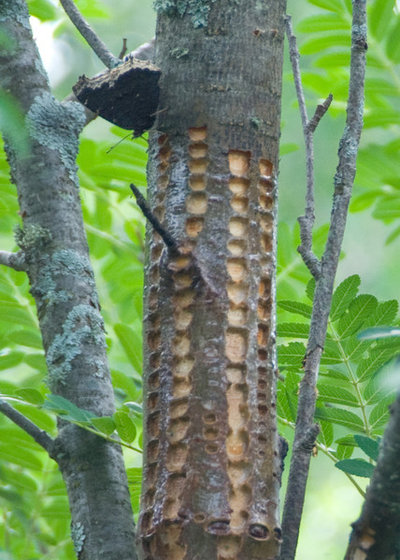
Holm Design & Consulting LLC
How They HelpMourning cloak butterflies are not frequent flower visitors. However, like many other butterfly species,
the new generation of adults that emerge in late June or July can often be found visiting flowers. They do so again later in the fall after they come out of dormancy. Any flower visitor has the potential to carry pollen to other flowers, aiding in the pollination of plants.
How to Spot Adult Mourning Cloak ButterfliesAdults. Mourning cloak butterflies are medium to large butterflies, with a wing span of 2.3 inches to 4 inches (6 to 10 centimeters). The interior fore and hind wings are dark brown with a light yellow or cream border and blue submarginal spots. The outside fore and hind wings are dark gray to brown with a cream or light yellow border.
Shown: An adult feeding at a sap flow on a mountain ash tree from holes created by a yellow-bellied sapsucker.
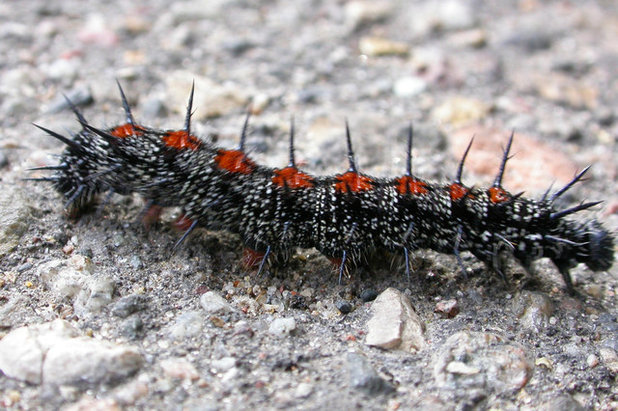
Holm Design & Consulting LLC
Babies (larvae or caterpillars). Caterpillars are black with long vertical and lateral spines. These sharp spines help deter predators and can be effective because the caterpillars feed in large groups. They have eight orange to red spots on the top of their thoracic and abdominal segments, and small speckled white spots on the entire body.
Mourning cloak caterpillars feed on their host plants in large aggregations, making them easy to spot on host plants. If provoked, they thrash their bodies in an attempt to scare off the potential predator. Once they are ready to pupate, they crawl to a new site away from the host plant.
Shown: A mourning cloak caterpillar on the move, probably leaving its host plant to prepare for pupation
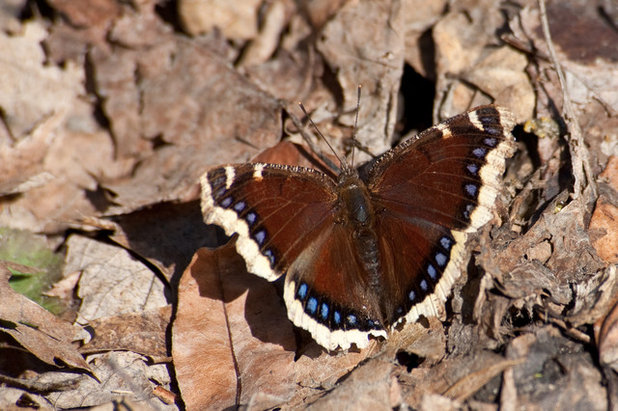
Holm Design & Consulting LLC
How to Lure ThemMaintain a pesticide-free yard. Don’t use pesticides, especially insecticides, in the garden, particularly on flowering plants or larval host plants (the plants caterpillars feed upon).
Shown: A newly emerged adult basking on the forest floor in early April.
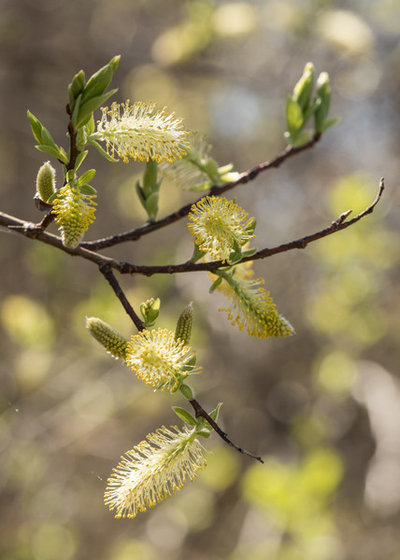
Holm Design & Consulting LLC
Provide larval host plants for caterpillars. Besides maintaining a pesticide-free garden and flowering plants in early spring, midsummer and fall, you’ll need to provide larval host plants. Caterpillars feed on the foliage of woody plants, including willow (
Salix spp.), poplar (
Populus spp.) and, less often, elm (
Ulmus spp.), hackberry (
Celtis occidentalis) and birch (
Betula spp.).
Shown: Females lay a large cluster of eggs on the stems of host plants, including plants like the willow seen here.
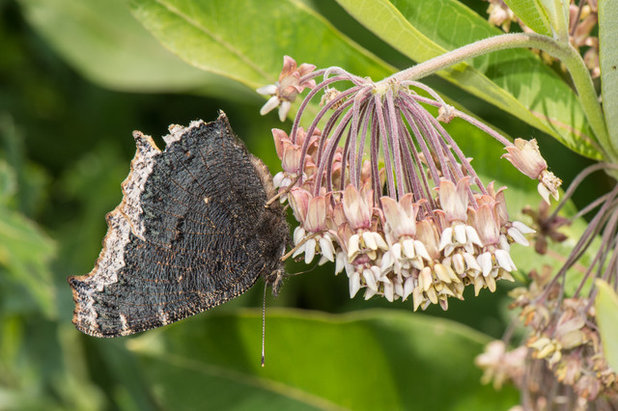
Holm Design & Consulting LLC
Offer forage and sap plants for adults. Mourning cloak adults get their nourishment in early spring from sap flows, often from maple trees, because there are no plants offering nectar that early. The new generation of adults that emerge in late June through July visit flowering plants for nectar, as they do in fall after coming out of dormancy.
Sample forage list for adults:- Spring: Sap of maple (Acer spp.), poplar (Populus spp.) and birch (Betula spp.) trees; cherry or plum flowers (Prunus spp.) and willow flowers (Salix spp.)
- Summer: Black-eyed Susan (Rudbeckia hirta), milkweed (Asclepias spp.), common yarrow (Achillea millefolium) and phlox (Phlox spp.). Adults also feed at sap flows from trees impacted by sapsuckers, including mountain ash (Sorbus spp.), maple and poplar.
- Late summer and fall: Goldenrod (Solidago and Euthamia spp.)
Shown: An adult foraging for nectar on common milkweed
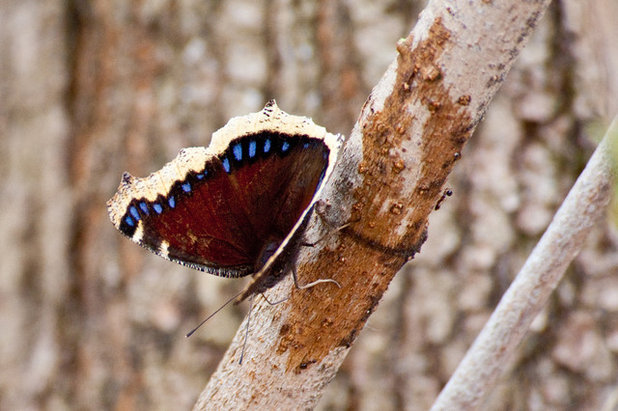
Holm Design & Consulting LLC
Life CycleMourning cloak butterflies overwinter as adults, and that’s why they are often the first butterfly observed on the wing in spring. These adults have spent the winter in an insulated place, such as behind a piece of bark, in a small cavity or hole in a tree or similar place out of sight of potential predators. These newly emerged adults often bask on the forest floor or perch on a dormant shrub, where they can absorb the early-spring rays from the sun.
When males and females emerge from their winter hibernacula (shelter), they mate, then seek out sap from trees or nectar from flowers. Females lay a large cluster of eggs that wrap around the stem of a woody host plant; eggs are frequently laid on willow, and less often on elm, poplar or birch trees.
The eggs hatch in about 10 days, and the caterpillars begin feeding on the newly emerged leaves of the host plant. The caterpillars form large feeding aggregations. They undergo five growth stages, called instars, shedding their skin four times between each growth stage. When they are ready to pupate — early June in the north — in the fifth instar stage, they crawl down and away from the host plant nearby, then hang from a large branch or another horizontal surface to begin pupation.
The first generation of adults emerge in mid to late June or early July, forage for a short time for nectar on flowers, then go dormant. Adults remain dormant through the hot, dry month of August, then come out of dormancy in September as temperatures cool. These adults fly late into the fall on warm days, then when temperatures drop, find a secure, insulated site in which to overwinter.
Shown: An adult feeding on sap from a box elder tree (
Acer negundo), a maple species





